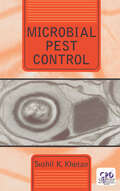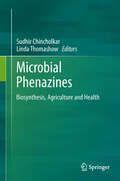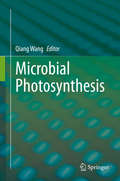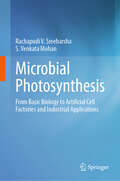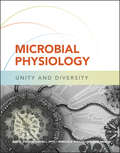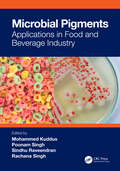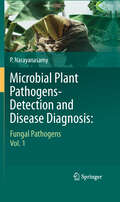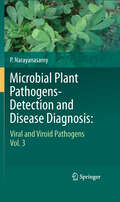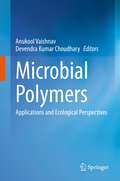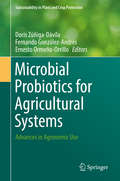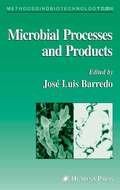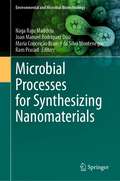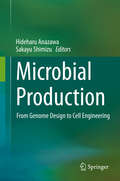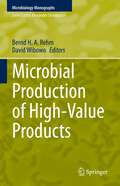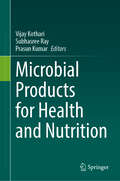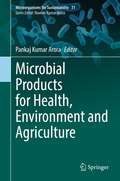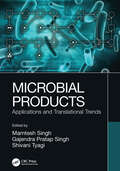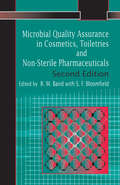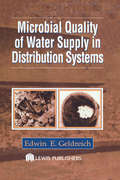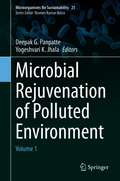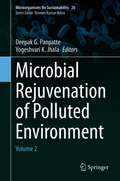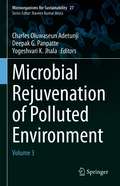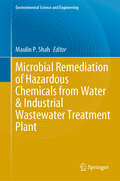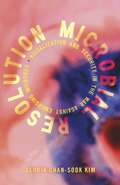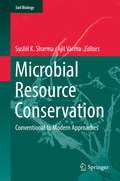- Table View
- List View
Microbial Pest Control
by Sushil KhetanA complete overview of the technologies and products for microbial-based pest control. It documents the use of genetically altered Bt and transgenic crops, microbial formulations, and synergistic interactions of microbials with synthetic chemicals, as well as the management of Bt foliar applications and Bt genes in transgenic crops. The book includ
Microbial Phenazines
by Sudhir Chincholkar Linda ThomashowMicrobial Phenazines: Biosynthesis, Agriculture and Health focuses on phenazines, a group of upwards of a hundred nitrogen-containing redox-active heterocyclic compounds of bacterial origin that have long attracted scientific interest because of their colorful pigmentation. Our understanding of these fascinating natural products and their role in human health and the environment has advanced rapidly in recent years, but we are only now beginning to be able to exploit the potential of these compounds in such fields as agriculture and medicine. This volume includes information on the biochemistry and genetics of phenazine synthesis, the physiological effects of phenazines, and methods for the isolation and identification of phenazines with the aid of spectroscopic and electrophoretic techniques. Also included are chapters focused on the roots of phenazine research in the biological control of plant pathogens and recent knowledge of the diversity of phenazine-producing microorganisms and the environments in which they occur. A final chapter addresses the potential of phenazines in the treatment of cancer.
Microbial Photosynthesis
by Qiang WangAs the largest scale chemical reaction, photosynthesis supplies all of the organic carbon and oxygen for life on Earth. It is estimated that the photosynthetic activity of microorganisms is responsible for more than 50% of the primary production of molecular oxygen on Earth. This book highlights recent breakthroughs in the multidisciplinary areas of microbial photosynthesis, presenting the latest developments in various areas of microbial photosynthesis research, from bacteria to eukaryotic algae, and from theoretical biology to structural biology and biophysics. Furthermore, the book discusses advances in photosynthetic chassis, such as in the context of metabolic engineering and green chemical production. Featuring contributions by leading authorities in photosynthesis research, the book is a valuable resource for graduate students and researchers in the field, especially those studying biological evolution and the origin of life.
Microbial Photosynthesis: From Basic Biology to Artificial Cell Factories and Industrial Applications
by Rachapudi V. Sreeharsha S. Venkata MohanThis book uncovers the basic principles of microbial photosynthesis and the latest technological interventions of this crucial phenomenon. In the recent past, the basic principles of microbial photosynthesis were technologically articulated to engineer several cell factories that can utilize waste resources and generate different groups of industrially valuable products. Also, the list of model organisms for specific usage have been increasing enormously. This volume covers the material in four sections; each of the part dealing with the basic principles of microbial photosynthesis in an applied orientation focusing on waste valorization and circular bioeconomy. Furthermore, the following chapters deal with the very recent advancements in metabolic engineering and artificial photosynthesis with respect to value addition. Not only will this book be available for graduate and postgraduate students in microbiology, biotechnology, plant sciences, environmental sciences, energy engineering, and renewable energy, it is also an excellent material for researchers needing a multidisciplinary approach.
Microbial Physiology: Unity and Diversity (ASM Books)
by Jayna L. Ditty Ann M. Stevens Rebecca E. Parales Susan M. MerkelMICROBIAL PHYSIOLOGY UNITY AND DIVERSITY Explore the fascinating world of microbes in Microbial Physiology: Unity and Diversity. This comprehensive, advanced undergraduate-level textbook takes readers on a captivating journey through the intricate and often underappreciated world of microbial physiology, emphasizing both the common features that unify microbes and the diversity that makes them unique. In Part I: Unity, the book lays a strong foundation in the basics of microbial physiology. Delve into the three domains of life, get an intimate look at the metabolic pathways that fuel the microbial world, and take a deep dive into the cellular components that constitute a microbe. Further, explore the principles of cellular growth, bioenergetics, and the mechanics of respiration and fermentation. The Unity section concludes with a comprehensive discussion of regulation at posttranslational and gene levels, paving the way for a rich understanding of microbial function. Part II: Diversity, takes the reader into the broad and versatile world of microbial metabolism, exploring the range of energy sources and metabolic pathways microbes employ. This section leads readers through topics such as autotrophy, phototrophy, chemotrophy, and microbial contributions to the carbon, sulfur, and nitrogen cycles. The complexity of microbial cell envelope structures, transport processes, and protein transport are explored, along with bacterial motility, chemotaxis, and the phenomenon of quorum sensing. The section concludes with an exploration of stress responses and the diverse lifestyles that bacteria can adopt. Microbial Physiology: Unity and Diversity will engage readers with its accessible yet thorough treatment of this critical field of microbiology. Each chapter contains detailed illustrations that concisely explain complex topics and concludes with robust end-of-chapter questions that not only test understanding but also provide an opportunity for readers to dig deeper into the content. This book is a must-have for students studying microbiology, as well as researchers and professionals keen to brush up their knowledge or explore new facets of microbial physiology.
Microbial Pigments: Applications in Food and Beverage Industry
by Mohammed Kuddus Rachana Singh Poonam Singh Raveendran SindhuMicrobial Pigments: Applications in Food and Beverage Industry offers a comprehensive and updated review of the impact of microbial pigments as value-added products in the food and beverage industry. Microbes produce a range of valuable pigments such as carotenoids, flavins, melanins, quinines, and violacein. The book explores the use of microbial pigments as additives, antioxidants, color intensifiers, and functional food ingredients. It discusses pigment isolation and processing technologies. It covers a range of applications across products like jams, spreads, frozen desserts, and beverages. The book also discusses food safety and toxicology aspects.Key features Explores the various microbial pigments and their sources Reviews the pigment isolation, production, and processing techniques Discusses the potential application of pigments across a range of products in the food and beverage industry Includes the latest innovations and patents awarded in use of microbial pigments as value-added food products The book is meant for researchers, academic and industry experts in food biotechnology, food processing, and food microbiology.
Microbial Plant Pathogens-Detection and Disease Diagnosis:
by P. NarayanasamyMorphological, biological, biochemical and physiological characteristics have been used for the detection, identification and differentiation of fungal pathogens up to species level. Tests based on biological characteristics are less consistent. Immunoassays have been shown to be effective in detecting fungal pathogens present in plants and environmental samples. Development of monoclonal antibody technology has greatly enhanced the sensitivity and specificity of detection, identification and differentiation of fungal species and varieties/strains. Nucleic acid-based techniques involving hybridization with or amplification of unique DNA have provided results rapidly and reliably. Presentation of a large number of protocols is a unique feature of this volume.
Microbial Plant Pathogens-Detection and Disease Diagnosis:
by P. NarayanasamyMicrobial plant pathogens causing qualitative and quantitative losses in all corps are present not only in the infected plants, but also in the environmental comprising of soil, water and air. The vectors present in the environment spread the microbial pathogens to short and/or long distances. Detection of microbial pathogens rapidly and reliably by employing suitable sensitive applicable for different ecosystems. The pathogens have to be identified precisely and differentiated and quantified to plan appropriate short- and long-term strategies to contain the incidence and spread of diseases induced by them. This book aims to present all relevant and latest information on the detection techniques based on the biological, biochemical, immunological and nucleic acid characteristics of microbial pathogens presents in the host plants, as well as in the natural substrates that support the survival and perpetuation of the pathogens.
Microbial Polymers: Applications and Ecological Perspectives
by Anukool Vaishnav Devendra Kumar ChoudharyThis book cover all types of microbe based polymers and their application in diverse sectors with special emphasis on agriculture. It collates latest research, methods, opinion, perspectives, and reviews dissecting the microbial origins of polymers, their production, design, and processing at industrial level, as well as improvements for specific industrial applications. Book also discusses recent advances in biopolymer production and their modification for amplifying the value. In addition, understanding of the microbial physiology and optimal conditions for polymer production are also explained. This compilation of scientific chapters on principles and practices of microbial polymers fosters the knowledge transfer among scientific communities, industries, and microbiologist and serves students, academicians, researchers for a better understanding of the nature of microbial polymers and application procedure for sustainable ecosystem
Microbial Probiotics for Agricultural Systems: Advances in Agronomic Use (Sustainability in Plant and Crop Protection)
by Fernando González-Andrés Doris Zúñiga-Dávila Ernesto Ormeño-OrrilloThe book is a comprehensive compilation of the most recent advances in the practical approach of the use of microbial probiotics for agriculture. Unlike the rest of the publications about biofertilizers, this book bridges the gap between the lab studies (molecular, physiological, omics, etc.) and the agronomic application.
Microbial Processes and Products
by José-Luis BarredoOutstanding experts in the use of microorganisms as cell factories describe in step-by-step detail their best laboratory procedures for a wide range of processes and products mediated by microorganisms. The diverse chemicals and biochemicals produced can be used in human health, nutrition, and environmental protection, and include semisynthetic derivatives of cephalosporins, erythromycin, antitumor compounds, plasmids for gene therapy and DNA vaccination , L-lysine, Vitamins B2 and B12, the sweet-tasting protein thaumatin, the carotenoids ß-carotene and astaxanthin, the polysaccharide gellan, and bacteria-producing bacteria for sausage fermentation, and many more. Also illustrated are the uses of phenylacetyl-CoA catabolon for the enzymatic synthesis of penicillins, aromatic biotransformation, syntheses of novel bioplastics, biosensor design, and the synthesis of drug vehicles. This book offers laboratory and industrial scientists a wealth of readily reproducible techniques for the microbial generation of biochemical products serving human health, nutrition, and environmental protection.
Microbial Processes for Synthesizing Nanomaterials (Environmental and Microbial Biotechnology)
by Naga Raju Maddela Ram Prasad Joan Manuel Rodríguez Díaz Maria Conceição Branco da Silva MontenegroThis contributed volume compiles the latest improvements in the field of nanobiotechnology, with a special emphasis on microbial-synthesized nanoparticles. It focuses on topics that comprise the microbials synthesized nanoparticles, their characterization, and applications in the field of medicine and biotechnology, which are organized in three parts, respectively. Ranging from micro-scale studies to macro, it covers a huge domain of nanotechnology in relevance to microbiology. Overall, the book portrays the importance of microbial processes in the sustainable production of nanomaterials to reduce the environmental burden caused by nanomaterials produced by chemical processes. The book is a ready reference for practicing students, researchers of nanobiotechnology, environmental biotechnology, and other allied fields likewise.
Microbial Production
by Hideharu Anazawa Sakayu ShimizuMicrobial production: From genome design to cell surface engineering affords a comprehensive review of novel technology and approaches being implemented for manufacturing microorganisms, written by specialists in both academia and industry. This book is divided into three sections: the first includes technology for improvement of fermentation strains and many supporting technologies and information; the second examines novel technology useful for analysis of cell activities, analyzing gene function, and designing genomes of producer strains; and finally, a discussion of the practical application of the techniques and success case studies in many fields of bio-production, such as microbiological production, pharmaceuticals, chemicals, foods and cosmetics.
Microbial Production of High-Value Products (Microbiology Monographs #37)
by Bernd H. A. Rehm David WibowoThis edited volume emphasizes how microorganisms have become a reliable pillar of biotechnology. The authors discuss advances in synthetic biology and genetic engineering that have made it possible to reprogram the microbial cellular capabilities. This enables an economically viable production of high-value products at an industrial level.The first part of the book provides an overview of synthetic biology and genome editing tools for engineering microbial cell factories in modern fermentation. Readers also learn how high-throughput bioprocessing methods are used to recover and purify microbial products.The remaining parts of this book explore the implementation and challenges of these upstream and downstream processing techniques for manufacturing high-value products. Cost-effectiveness and quality-control are key factors, when discussing the production of low-molecular-weight products, biopharmaceuticals, biopolymers and protein-based nanoparticles.This book is a valuable resource for biotechnologists both in the industry and in academia.
Microbial Products for Health and Nutrition
by Prasun Kumar Vijay Kothari Subhasree RayThis book highlights microbial products and their applications in the health sector. The chapters introduce novel advancements and applications in different pharmaceutical and nutraceutical aspects of applied microbiology. Readers will obtain a detailed overview of the relevance of microbial metabolites to human health and nutrition. Besides knowing the products already developed, they will also get an idea of microbial products currently in the development pipeline and those that are likely to emerge as potential nutraceuticals. Readers will get an interesting and useful perspective on how supplementing food with microbes or their bioactive metabolites can realize the idea of 'food as medicine'. This book introduces the biological activities of various microbial fermentation products, and how they are relevant to mitigating various disease conditions (e.g. neuropathy, diabetes, gut dysbiosis, malnutrition, etc.) in humans. One of the highlights of this volume is the exploration of microbial pigments as potential substitutes for synthetic colorants, offering safer and more sustainable alternatives for the food and healthcare industries. The book has equivalent contributions from experts in academia and industry to fill the communication gap between them. Through this book, readers will gain valuable insights into the historical perspectives, contemporary impacts, and future prospects of microbial applications in health and nutrition. From food preservation to biopharmaceutical production, the potential of microbial products to revolutionize our approach to health and wellness is undeniable.
Microbial Products for Health, Environment and Agriculture (Microorganisms for Sustainability #31)
by Pankaj Kumar AroraThis edited volume discusses the role of various microbial products in healthcare, environment and agriculture. Several microbial products are directly involved in solving major health problems, agricultural and environmental issues. In healthcare sector, microbes are used as anti-tumor compounds, antibiotics, anti-parasitic agents, enzyme inhibitors and immunosuppressive agents. Microbial products are also used to degrade xenobiotic compounds and bio-surfactants, for biodegradation process. In agriculture, microbial products are used to enhance nutrient uptake, to promote plant growth, or to control plant diseases. The book presents several such applications of microbes in the ecosystems. The chapters are contributed from across the globe and contain up-to-date information. This book is of interest to teachers, researchers, microbiologists and ecologists. Also the book serves as additional reading material for undergraduate and graduate students of agriculture, forestry, ecology, soil science, and environmental sciences.
Microbial Products: Applications and Translational Trends (Microbial Biotechnology for Food, Health, and the Environment)
by Mamtesh Singh Gajendra Pratap Singh Shivani TyagiMicrobial Products: Applications and Translational Trends offers complete coverage of the production of microbial products, including biopolymers, biofuels, bioactive compounds, and their applications in fields such as bioremediation, agriculture, medicine, and other industrial settings. This book focuses on multiple processes including upstream procedures and downstream processing, and the tools required for their production. Lab-scale development processes may not be as efficient when aiming for large-scale industrial production, so it is necessary to utilize in silico modeling tools for bioprocess design to ensure success at translational levels. Therefore, this book presents in silico and mathematical simulations and approaches used for such applications. Further, it examines microbial products produced from bacteria, fungi, and algae. These major microbial categories have the capacity to produce various, diverse secondary metabolites, bioactive compounds, enzymes, biopolymers, biofuels, probiotics, and more. The bioproducts examined in the book are of great social, medical, and agricultural benefit, and include examples of biodegradable polymers, biofuels, biofertilizers, and drug delivery agents. Presents approaches and tools that aid in the design of eco-friendly, efficient, and economic bioprocesses. Utilizes in silico and mathematical simulations for optimal bioprocess design. Examines approaches to be used for bioproducts from the lab scale to widely applied microbial biotechnologies. Presents the latest trends and technologies in the production approaches for microbial bio-products manufacture and application. This book is ideal for both researchers and academics, as it provides up-to-date knowledge of applied microbial biotechnology approaches for bio-products.
Microbial Quality Assurance in Pharmaceuticals, Cosmetics, and Toiletries (Taylor And Francis Series In Pharmaceutical Sciences Ser.)
by R. Baird Sally F. BloomfieldThe importance of quality assurance in the production, storage and use of manufactured preparations is widely recognized. This book encapsulates the issues involved in the manufacture of non-steriles, such as creams, ointments, herbal remedies, shampoos, soaps and toiletry products (as opposed to sterile drugs and injectible products). Knowledge of the microbial limits is expanded, new standards are included, and coverage of the preservation issues of dosage forms is widened to include semi-solids and liquid preparations. This edition also contains new regulations regarding preservative efficacy testing and covers pharmacopoeial and industry regulations and guidelines. Rapid methods are also discussed, now more common in cosmetic and toiletry practice, in their pharmaceutical capacity.
Microbial Quality of Water Supply in Distribution Systems
by Edwin E. GeldreichHidden problems, buried deep in the pipe networks of water distribution systems, are very serious potential threats to water quality. Microbial Quality of Water Supply in Distribution Systems outlines the processes and issues related to the degradation of water quality upon passage through networks of pipes, storage reservoirs, and standpipes on its way to the consumer. The risks associated with biofilm accumulation, bacteria, and other contaminants are discussed in great detail. In addition to its excellent microbiological coverage of organisms in drinking water and biofilms in distribution systems, Microbial Quality of Water Supply in Distribution Systems provides clear treatments of the technical and public communication issues most commonly affecting the quality of water and water supply systems. The inclusion of numerous case histories in this new book makes it a complete reference source for anyone concerned with water quality and water distribution systems.
Microbial Rejuvenation of Polluted Environment: Volume 1 (Microorganisms for Sustainability #25)
by Deepak G. Panpatte Yogeshvari K. JhalaPollution is one of the most serious issues facing mankind and other life forms on earth. Environmental pollution leads to the degradation of ecosystems, loss of services, economic losses, and various other problems. The eco-friendliest approach to rejuvenating polluted ecosystems is with the help of microorganism-based bioremediation. Microorganisms are characterized by great biodiversity, genetic and metabolic machinery, and by their ability to survive, even in extremely polluted environments. As such, they are and will remain the most important tools for restoring polluted ecosystems / habitats. This three-volume book sheds light on the utilization of microorganisms and the latest technologies for cleaning up polluted sites. It also discusses the remediation or degradation of various important pollutants such as pesticides, wastewater, plastics, PAHs, oil spills etc. The book also explains the latest technologies used for the degradation of pollutants in several niche ecosystems. Given its scope, the book will be of interest to teachers, researchers, bioremediation scientists, capacity builders and policymakers. It also offers valuable additional reading material for undergraduate and graduate students of microbiology, ecology, soil science, and the environmental sciences.
Microbial Rejuvenation of Polluted Environment: Volume 2 (Microorganisms for Sustainability #26)
by Deepak G. Panpatte Yogeshvari K. JhalaPollution is one of the most serious issues facing mankind and other life forms on earth. Environmental pollution leads to the degradation of ecosystems, loss of services, economic losses, and various other problems. The eco-friendliest approach to rejuvenating polluted ecosystems is with the help of microorganism-based bioremediation. Microorganisms are characterized by great biodiversity, genetic and metabolic machinery, and by their ability to survive, even in extremely polluted environments. As such, they are and will remain the most important tools for restoring polluted ecosystems / habitats. This three-volume book sheds light on the utilization of microorganisms and the latest technologies for cleaning up polluted sites. It also discusses the remediation or degradation of various important pollutants such as pesticides, wastewater, plastics, PAHs, oil spills etc. The book also explains the latest technologies used for the degradation of pollutants in several niche ecosystems. Given its scope, the book will be of interest to teachers, researchers, bioremediation scientists, capacity builders and policymakers. It also offers valuable additional reading material for undergraduate and graduate students of microbiology, ecology, soil science, and the environmental sciences.
Microbial Rejuvenation of Polluted Environment: Volume 3 (Microorganisms for Sustainability #27)
by Deepak G. Panpatte Yogeshvari K. Jhala Charles Oluwaseun AdetunjiPollution is one of the most serious issues facing mankind and other life forms on earth. Environmental pollution leads to the degradation of ecosystems, loss of services, economic losses, and various other problems. The eco-friendliest approach to rejuvenating polluted ecosystems is with the help of microorganism-based bioremediation. Microorganisms are characterized by great biodiversity, genetic and metabolic machinery, and by their ability to survive, even in extremely polluted environments. As such, they are and will remain the most important tools for restoring polluted ecosystems / habitats. This three-volume book sheds light on the utilization of microorganisms and the latest technologies for cleaning up polluted sites. It also discusses the remediation or degradation of various important pollutants such as pesticides, wastewater, plastics, PAHs, oil spills etc. The book also explains the latest technologies used for the degradation of pollutants in several niche ecosystems. Given its scope, the book will be of interest to teachers, researchers, bioremediation scientists, capacity builders and policymakers. It also offers valuable additional reading material for undergraduate and graduate students of microbiology, ecology, soil science, and the environmental sciences.
Microbial Remediation of Hazardous Chemicals from Water & Industrial Wastewater Treatment Plant (Environmental Science and Engineering)
by Maulin P. ShahThis book discusses the new and emerging innovative trends in the bioremediation of hazardous pollutants found in wastewater. It also includes the fate of pollutants produced after the treatment process both at the laboratory scale and at the industrial scale. The book intrusively explores the unique biological aspects of the wastewater treatment process and highlights the advantages they provide for engineering applications in the industries. Each chapter covers a different biological-based approach and examines the basic principles, practical applications, recent breakthroughs, and associated limitations. It presents an array of cutting-edge wastewater treatment research and thereafter its applications in treatment, remediation, sensing, and pollution prevention processes. The biological process for application in wastewater research has a significant impact on maintaining the long-term quality, availability, and viability of water. This book elucidates the technologies of biological wastewater treatment processes. The biological processes presented in wastewater treatment processes include (1) bioremediation of wastewater that includes aerobic treatment (oxidation ponds, aeration lagoons, aerobic bioreactors, activated sludge, percolating or trickling filters, biological filters, rotating biological contactors, biological removal of nutrients) and anaerobic treatment (anaerobic bioreactors, anaerobic lagoons); (2) phytoremediation of wastewater that includes constructed wetlands, rhizofiltration, rhizodegradation, phytodegradation, phytoaccumulation, phytotransformation, and hyperaccumulators; and (3) mycoremediation of wastewater. The book describes a broad area of biological processes and water research which are considered key components for advanced water purification. It also includes the desalination technologies that remove, reduce, or neutralize water contaminants that threaten human health and/or ecosystem productivity and integrity.
Microbial Resolution: Visualization and Security in the War against Emerging Microbes (Proximities)
by Gloria Chan-Sook KimAn interdisciplinary study charting the war against microbial futures leads to a new theory of contemporary vision and visuality In 1989, a group of U.S. government scientists met to discuss some surprising findings: new diseases were appearing around the world, and viruses that they thought long vanquished were resurfacing. Their appearance heralded a future perpetually threatened by unforeseeable biological risks, sparking a new concept of disease: the &“emerging microbe.&” With the Cold War nearing its end, American scientists and security experts turned to confront this new &“enemy,&” redirecting national security against its risky horizons. In order to be fought, emerging microbes first needed to be made perceptible; but how could something immaterial, unknowable, and ever mutating be coaxed into visibility, knowability, and operability? Microbial Resolution charts the U.S.-led war on the emerging microbe to show how their uncertain futures were transformed into objects of global science and security. Moving beyond familiar accounts that link scientific knowledge production to optical practices of visualizing the invisible, Gloria Chan-Sook Kim develops a theory of &“microbial resolution&” to analyze the complex problematic that arises when dealing with these entities: what can be seen when there is nothing to see? Through a syncretic analysis of data mining, animal-tracking technologies, media networks, computer-modeled futures, and global ecologies and infrastructures, she shows how a visual impasse—the impossibility of seeing microbial futures—forms the basis for new modes of perceiving, knowing, and governing in the present. Timely and thought provoking, Microbial Resolution opens up the rich paradoxes, irreconcilabilities, and failures inherent in this project and demonstrates how these tensions profoundly animate twenty-first-century epistemologies, aesthetics, affects, and ecologies.
Microbial Resource Conservation: Conventional to Modern Approaches (Soil Biology #54)
by Ajit Varma Sushil K. SharmaThis book covers broad areas in the conservation of microorganisms. It addresses the short, medium and long-term preservation of agriculturally important microorganisms, as well as culture collections and their roles. The respective chapters address topics such as conventional approaches to bacterial, fungal and algal preservation, as well as methods and strategies for preserving recalcitrant microorganisms. Readers will also find the latest insights into the preservation of vesicular-arbuscular (VA) fungi and ecology, diversity and conservation of endophytes, and entamopathogenic fungi. Microbes of animal and dairy origin, their preservation and biosafety issues are also explored. Microorganisms are the silent and unseen majority of life on Earth, and are characterized by a high degree of genetic and metabolic diversity. It is well documented that no branch of science or society is unaffected by microbial interventions. Researchers have documented microorganisms from such extreme and unique environments as deserts and hydrothermal vents, and with specific traits that are currently being exploited in agriculture, industry, medicine and biotechnological applications. Such great potential can only be found in microorganisms. The aim of this book – the first entirely devoted to the conservation of microorganisms, and to regulatory mechanisms for access and benefits sharing as per Biological Diversity (BD) Act 2002 – is to promote awareness of our world’s microbial wealth, and to introduce readers to strategies and methodologies for the conservation of microorganisms, which could ultimately save human life on Earth.
